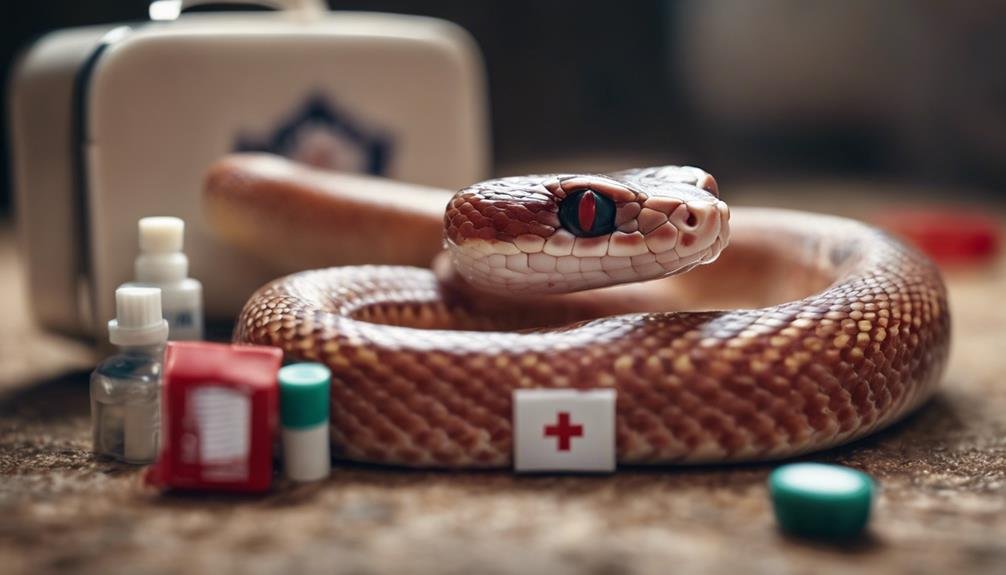If you've ever pondered whether corn snakes can bite, you're not alone. These popular pets are generally docile, but like any animal, they can bite if frightened or startled. The pain level from a corn snake bite can vary, often described as a scratch from a hatchling or a sharp pinch from an adult. While these bites aren't venomous, they can introduce bacteria, making proper treatment essential. You might be wondering how to treat a bite and what steps you can take to prevent future incidents. In exploring these aspects, you'll discover practical tips and insights that can enhance your relationship with these fascinating creatures.
Key Takeaways
- Corn snakes can bite, but their bites are non-venomous and typically feel like a gentle scratch or a sharp pinch.
- The pain level from a corn snake bite varies with the snake's age and bite location but is generally minor.
- Immediate care for a corn snake bite includes cleaning the area with soap and water and applying antiseptic ointment.
- Bites are rare and often a result of the snake feeling threatened or mistaken handling.
- Preventing future bites involves calm, steady handling and avoiding sudden movements to reduce startling the snake.
Does a Corn Snake Bite Hurt?
While a corn snake's bite might feel like a gentle scratch due to their non-venomous nature, the level of pain can vary based on the snake's age and where you're bitten. If it's a hatchling that's got you, you're likely to only feel minor discomfort, akin to a pinprick. An adult corn snake, however, can deliver a bite that feels more like a sharp pinch. It's important to remember that regardless of the pain, snake bites, including those from a corn snake, can introduce bacteria to your skin.
Proper snake care is vital to minimize the chances of getting bitten in the first place. Handling your corn snake regularly, but with respect to its mood and body language, can help in building trust between you and your snake. If you do get bitten, it's crucial to clean the wound promptly with soap and water to prevent infection. Despite the potential for discomfort, corn snake bites are generally not dangerous. With the right care and handling techniques, such incidents can be rare, allowing you and your corn snake to enjoy a harmonious relationship.
Do Corn Snakes Bite?
Corn snakes can occasionally bite if they feel threatened or are startled, but such incidents are rare with proper handling and care. These gentle creatures are known for their docile nature, making them one of the more popular choices for pet snakes. However, like any animal, a corn snake may bite if it finds itself in a stressful situation or if it mistakes your hand for food.
When handling your snake, it's important to do so with calm and steady movements to avoid startling it. Bites from corn snakes are usually more like gentle scratches due to their small teeth and are not dangerous. They might cause minor discomfort but are far from being a serious concern.
Here's a quick overview to help you understand the nature of corn snake bites:
| Aspect | Detail | Relevance |
|---|---|---|
| Frequency | Rare with proper handling | Low risk of occurrence |
| Severity | Gentle scratches | Minor discomfort |
| Prevention | Calm, steady handling | Reduces likelihood |
| Danger Level | Not dangerous | Safe for humans |
| Snake Temperament | Docile | Bites uncommon |
Is the Corn Snake Venomous?
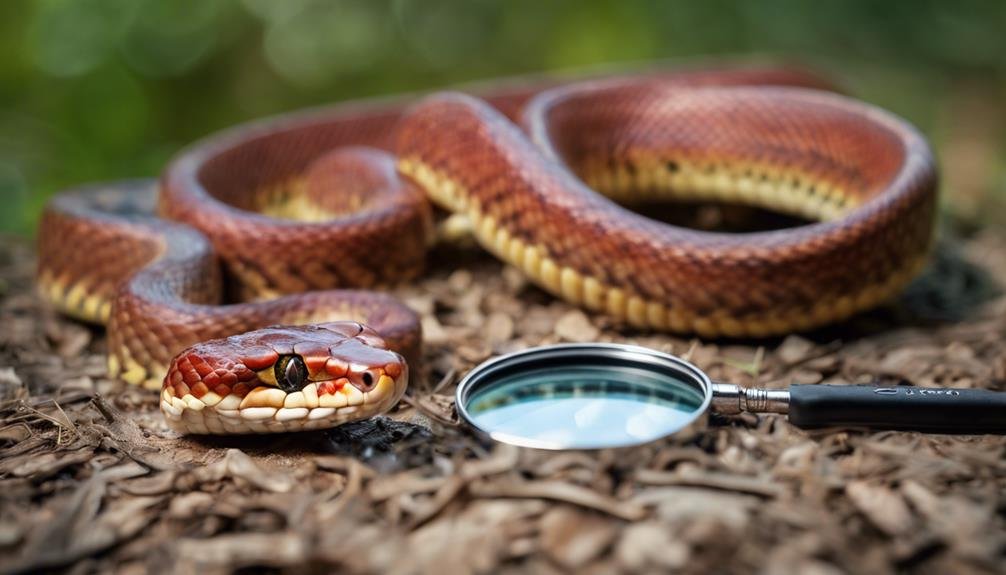

Despite their ability to bite, corn snakes are non-venomous and pose no venomous threat to humans. These vibrant reptiles rely on constriction, not venom, to subdue their prey. They lack the venom glands that characterize their venomous counterparts, which means they don't inject venom through their bites. This absence of venom makes corn snake bites harmless in the context of toxicity.
You might wonder about the significance of this non-venomous nature. It means that corn snakes are safe to handle, even if they occasionally bite. Unlike encounters with venomous snakes, where a bite could lead to serious health issues, a corn snake's bite doesn't come with this concern. It's a reassuring fact for pet owners and reptile enthusiasts alike, emphasizing the suitability of corn snakes as pets, especially for those new to keeping snakes.
Corn Snake Bite Symptoms
If you're bitten by a corn snake, you might experience mild discomfort similar to a scratch. Corn snake bites are generally not severe, but it's important to know what symptoms you may encounter. The bite itself may not break the skin deeply, but you could see some slight bleeding. Often, the symptoms are minor and can be handled with simple first aid measures.
Here's what you might expect following a corn snake bite:
- Localized Pain: The area around the bite mark may hurt, resembling the sensation you'd feel from a small scratch or pinch. This discomfort is usually short-lived.
- Redness or Swelling: You might notice some redness or slight swelling around the bite mark. This is your body's natural response to the bite.
- Slight Bleeding: In some cases, there may be a bit of bleeding. Corn snake bites don't typically cause deep wounds, so any bleeding should be minor.
Why Corn Snakes Bite
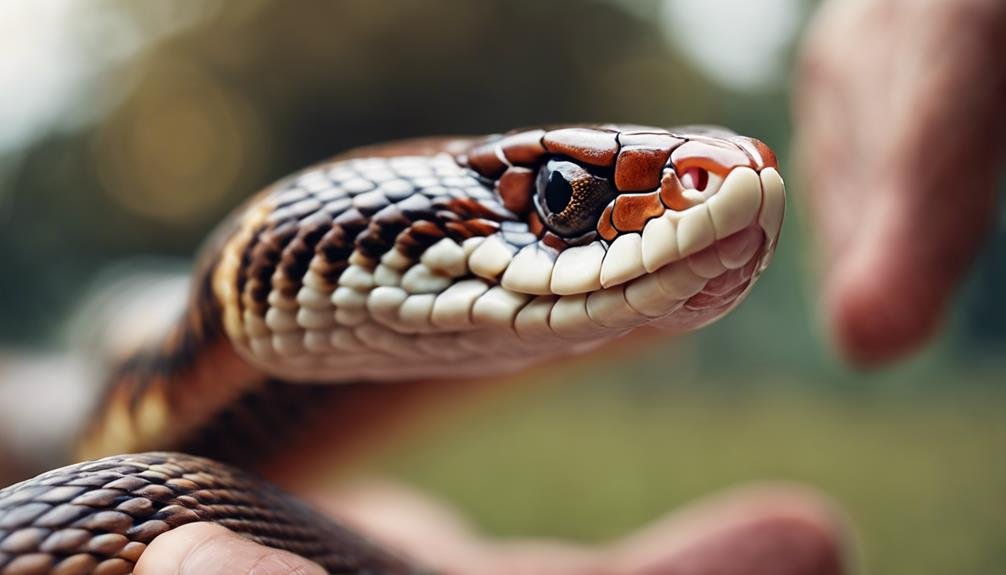

You might wonder why a corn snake would bite if they're generally known for their docile nature.
It's often a reaction to feeling threatened, whether it be from sudden movements, hunger, or even the stress of shedding.
Understanding the reasons behind these defensive behaviors, such as misinterpreting hunger signals or making handling mistakes, is vital in preventing bites.
Defensive Behavior Explained
Understanding why corn snakes might bite is crucial for anyone looking to handle them safely. These creatures may resort to defensive bites when they're startled, feel threatened, or mistake your hand for food. Improving your handling techniques and recognizing what triggers these defensive behaviors can greatly reduce the chances of a bite.
Here are three key points to remember:
- Avoid sudden movements that can startle your corn snake, especially during vulnerable times like shedding.
- Minimize external stressors, such as loud noises, to keep your snake calm.
- Refine your handling techniques to make sure you're not perceived as a threat or a food source.
Hunger Signals Misinterpreted
While defensive behavior is one factor, another common reason corn snakes may bite is due to misinterpreting hunger signals. When hungry, these snakes might mistake your fingers for food, especially if their feeding schedule is irregular. This is because they rely heavily on their sense of smell to detect food, leading to potential mistaken bites.
To prevent these hunger-induced nips, regularly feeding corn snakes is essential. Establishing a consistent feeding routine helps them understand when to expect food, reducing the likelihood of them seeing your hand as a meal. Additionally, it's wise to avoid handling them when they're in feeding mode, as this is when they're most likely to misinterpret your intentions and accidentally bite.
Handling Mistakes Identified
Handling corn snakes improperly can often lead to defensive bites, highlighting the necessity for careful and informed interaction. To guarantee you're not making common mistakes that could provoke your pet, consider these key points:
- Avoid Sudden Movements: Quick, unexpected actions can startle corn snakes, making them feel threatened and more likely to bite in defense.
- Be Mindful During Shedding: Shedding stress can make corn snakes more irritable. Handle them gently, if at all, during this period to avoid causing discomfort that could lead to a defensive bite.
- Maintain a Calm Environment: Loud noises and other external stressors can agitate your snake. Keeping their surroundings quiet and peaceful minimizes stress, reducing the likelihood of bites due to improper handling techniques.
Treating a Corn Snake Bite
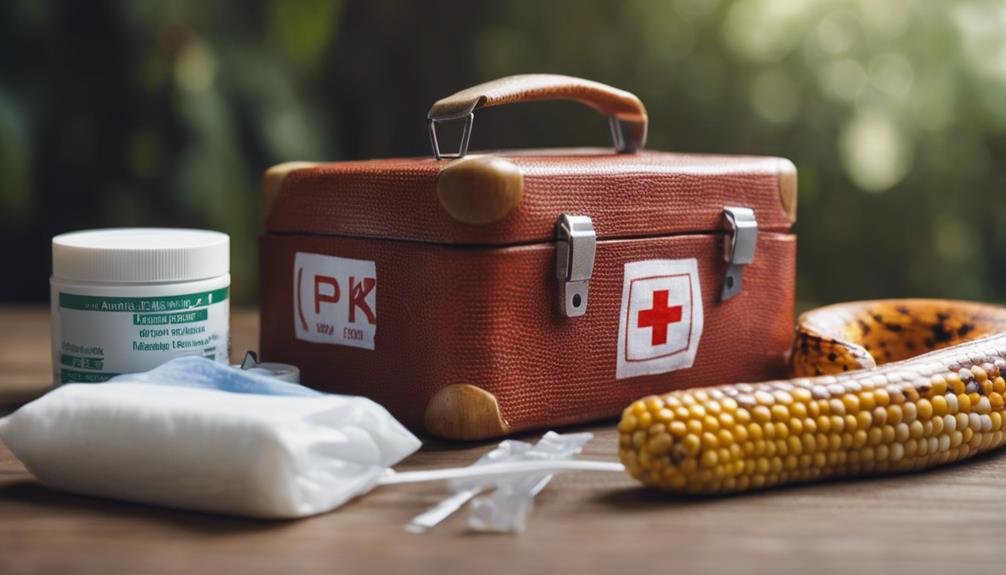

After a corn snake bite, it's essential you assess how severe it's right away.
You'll need to know the immediate steps to care for the wound, such as cleaning and covering it, to prevent infection.
Lastly, understanding how to prevent future bites can guarantee both you and your snake remain happy and healthy.
Assessing the Bite Severity
To assess the severity of a corn snake bite, consider the snake's age, the bite location on your body, and your personal pain tolerance. Bite severity can vary greatly, from a minor scratch that barely registers to a more piercing sensation if the snake is an adult. Here's a quick guide:
- Evaluate the Pain: A hatchling's bite might feel like a pinch, whereas an adult's can be sharper.
- Notice Psychological Impact: Don't underestimate the shock or fear factor, which can amplify how severe the bite feels.
- Inspect the Wound: If the skin is broken, promptly disinfect the area to prevent infection.
Understanding these factors will help you gauge the bite's severity accurately and take the appropriate steps to treat it effectively.
Immediate Care Steps
Upon receiving a bite from a corn snake, your first step should be to clean the affected area with mild soap and water. This initial action helps prevent infection, setting the stage for proper healing.
After thoroughly cleaning, applying an antiseptic ointment is vital. This not only further reduces the risk of infection but also promotes the wound's healing process.
It's important to keep an eye on the bite site for any signs of redness, swelling, or unusual discharge, as these could indicate an infection is developing. If the bite becomes increasingly painful or shows any signs of infection, seeking medical attention becomes necessary.
Preventing Future Bites
Minimizing the chances of future corn snake bites involves understanding and addressing the factors that may provoke these incidents. By focusing on the skin surrounding your gentle interactions with your corn snake, you can greatly reduce the likelihood of unexpected bites.
Here are three key steps to enjoy a bite-free relationship with your slithery friend:
- Avoid sudden movements that might startle your corn snake, ensuring a calm and stress-free environment.
- Maintain regular feeding schedules to prevent hunger-induced bites, demonstrating the importance of understanding their dietary needs.
- Practice proper handling techniques, including gentle support and avoiding overhandling, especially during sensitive times like shedding.
How Does a Corn Snake’s Vision Affect Its Tendency to Bite?
Corn snake vision capabilities play a significant role in their tendency to bite. Their excellent vision allows them to accurately target and strike at prey, but it also makes them more likely to perceive movement as a threat. Understanding their vision capabilities can help minimize the likelihood of getting bitten.
Preventing Future Bites
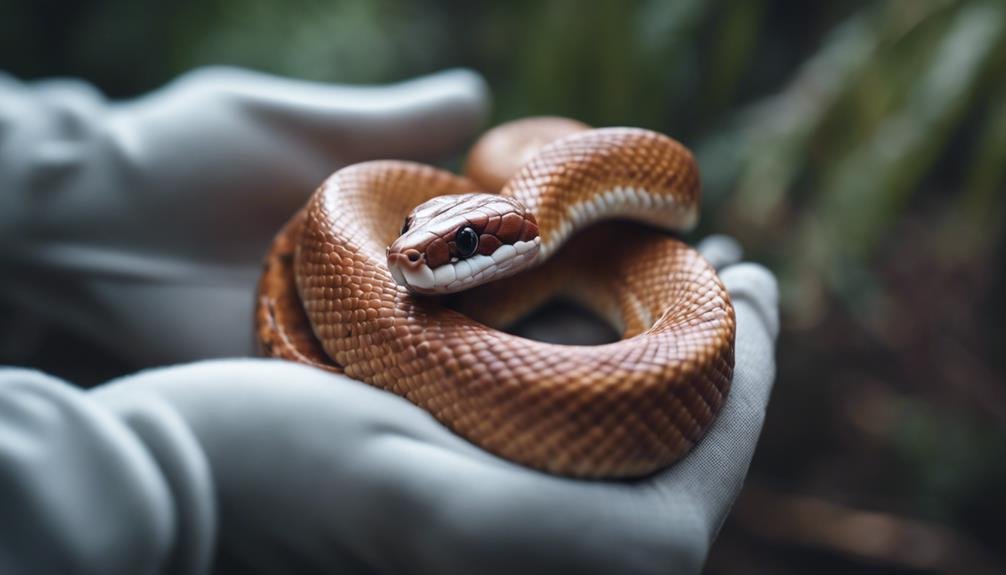

Avoiding future bites from your corn snake involves gentle handling and understanding their needs. First and foremost, it's essential to master proper handling techniques. Approach your snake calmly, without sudden movements, to keep them relaxed during interactions. Ensuring your corn snake is well-fed also plays an important role in preventing bites. A hungry snake might mistake your hand for food, leading to an accidental bite. Hence, maintaining a regular feeding schedule that satisfies their dietary needs is vital.
Creating a stress-free environment for your corn snake is another key strategy. Minimize loud noises and abrupt changes in their habitat to avoid startling them. Additionally, support your corn snake during their shedding process. Discomfort during shedding can increase the likelihood of biting, so providing a humid hide and facilitating the removal of shed skin can prevent this.
Educating yourself on these aspects helps build a trusting relationship between you and your corn snake. Remember, understanding and patience are your best tools in preventing future bites. By following these guidelines, you'll create a harmonious environment for both you and your snake, greatly reducing the chances of an unwanted bite.
Conclusion
In conclusion, while corn snakes can bite, the pain is usually minimal, similar to a scratch or a pinch, depending on their age. They're not venomous, but it's important to clean the bite promptly to prevent infection.
Understanding why they might bite and practicing proper handling can help avoid future incidents. Remember, with the right care and attention, you can minimize the chances of a bite and enjoy a harmonious relationship with your corn snake.

